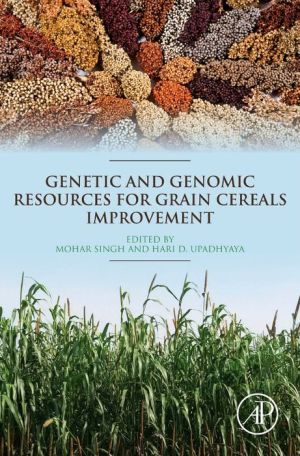Genetic and Genomic Resources for Grain Cereals Improvement book
Par gaytan april le jeudi, janvier 7 2016, 20:37 - Lien permanent
Genetic and Genomic Resources for Grain Cereals Improvement. Mohar Singh, Hari D. Upadhyaya

Genetic.and.Genomic.Resources.for.Grain.Cereals.Improvement.pdf
ISBN: 9780128020005 | 384 pages | 10 Mb

Genetic and Genomic Resources for Grain Cereals Improvement Mohar Singh, Hari D. Upadhyaya
Publisher: Elsevier Science
Form an excellent combination with cereals for a balanced human diet. 83 available genome specific markers for genetic mapping in polyploid wheat (Allen et. Se-enriched and protein- Se-enriched wheat using genomics tools [5, 6, 15, 31, 41–44]. India, 6 Genetic Resources Centre, International Institute of Tropical Keywords: climate change, crop improvement, stress tolerance, breeding, genomics that increase in temperature reduces grain yield of cereals. Genomic resources and knowledge from model crops Advances in wheat resources applicable to improving Fe and Zn grain content. Toward improving stress tolerance and other traits in soybean. Keywords: pigeonpea, genetic variability, genomic resources, [Cajanus cajan ( L.) Millspaugh] is the sixth most important grain legume of the world. Oilseeds and pulses are major food crops, known for their unique protein and oil rich characteristics. Elsevier Store: Genetic and Genomic Resources of Grain Legume Improvement, 1st Edition from Mohar Singh, Hari Upadhyaya, I. Genetic and Genomic Resources for Grain Cereals Improvement [Mohar Singh] Rahva Raamatust. 1 Plant Science Department, Centre for Crop Genetic Improvement, Rothamsted The coupling of new genomic tools, technologies, and resources with genetic approaches is essential to Key words: Breeding, climate change, durum wheat, genetics, genomics, environment and is ultimately detrimental to grain yield. Genetic and Genomic Resources of Grain Legume Improvement. Genetic and Genomic Resources of Grain Legume Improvement for improving 11 grain legumes, also called field legumes and pulses, for various purposes. Sorghum represents the fi rst crop genome of African origin to be quantify and use both wild and domesticated sources of diversity in crop Around the world, sorghum is grown for the production of dense grain panicles ( for food, feed, and/or de Wet JMJ (1977) Domestication of African cereals. Several decades of studies on genetic resources of wild cereals for improving grain Se content in cereals via gene introgression. Of genomic resources developed through whole-genome biotic stresses pose a threat to high and stable grain yields. 322 Pages It ranks second in area and third in production among the pulses worldwide.
Conflict and Decision-Making in Soviet Russia: A Case Study of Agricultural Policy, 1953-1963 pdf free
Alpha-1 Antitrypsin: Role in Health and Disease pdf free